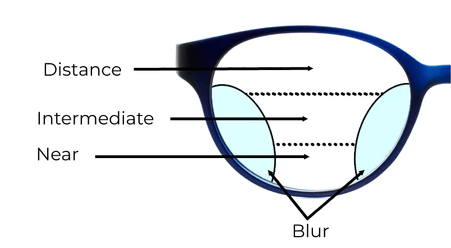Progressive multifocal fitting process
1. Communicate and understand your vision needs, and ask about your glasses history, occupation, and requirements for new glasses.
2. Computer optometry and single-eye interpupillary distance measurement.
3. Naked/original spectacle vision examination, when determining the distance diopter, must be based on the diopter of the original glasses and the requirements for distance vision.
4. The principle of retinoscopy and subjective refraction (distance vision) to determine the distance diopter is: based on the principle of acceptable distance vision, myopia can be as shallow as possible, hyperopia can be as sufficient as possible, and astigmatism is added. Be cautious and keep your eyes balanced.
5. For distance vision correction, adjust and confirm the lens with the distance diopter in front of the subject's eyes, and let the subject wear it to determine whether the distance diopter is acceptable.
6. Near-presbyopia/presbyopia measurement.
7. Try on the near vision correction, adjust and confirm.
8. Introduction and selection of progressive lens types and materials.
9. It is recommended to choose a frame. Choose the corresponding frame according to the different progressive lenses you choose, and ensure that there is sufficient vertical distance from the center of the pupil to the lowest point of the lower edge of the frame.
10. Frame shaping, the distance between the eyeglasses is 12~14mm. The forward tilt angle is 10°~12°.
11. Single eye pupil height measurement.
12. Determination of progressive film measurement parameters.
13. Guidance on the use of progressive lenses. There are markings on the lenses. Check whether the crosshairs are located in the center of the pupil and determine the use of all distances.
Progressive multifocal frame selection
For the selection of frames, it is first required that the center point of the pupil to the inner edge of the lower frame of the frame is generally not less than 22mm. The height of the standard channel 18mm or 19mm frame should be ≥34mm, and the short channel 13.5 or 14mm frame height should be ≥ 30mm, and avoid choosing frames with a large bevel on the nose side, because it is easy to "cut off" the reading area. Try not to choose frameless frames, which are easier to loosen and change various parameters. Also be sure to choose frames with adjustable nose pads.
Progressive multi-focus marking
Before measuring, the frame must be adjusted and calibrated to obtain the best balance. The distance between the eyeglasses is generally 12-13mm, the forward angle is 10-12 degrees, and the length of the temples is appropriate.
1. The examiner and the person being examined sit opposite each other and keep their eyesight at the same level.
2. The examiner holds a marker pen in his right hand, closes his right eye, opens his left eye, holds a pen-type flashlight in his left hand and puts it under the lower eyelid of the left eye, and asks the examinee to look at the examiner's left eye. Mark the interpupillary distance with cross lines on the sample of glasses based on the reflection from the center of the pupil of the subject. The vertical distance from the intersection of the cross lines to the lower inner edge of the frame is the pupil height of the subject's right eye.

3. The examiner holds a marker in his right hand, closes his left eye, opens his right eye, holds a penlight in his left hand and puts it under the lower eyelid of his right eye, asking the examinee to look at the examiner's right eye. Mark the interpupillary distance with cross lines on the sample of glasses based on the reflection from the center of the pupil of the subject. The vertical distance from the intersection of the cross lines to the lower inner edge of the frame is the pupil height of the subject's left eye.

Write to the end
Progressive multifocal lenses are expensive to make and are functional lenses. They are aimed at people with insufficient adjustment ability. They cannot see clearly at close range (reading distance 30 cm), whether with naked eyes or wearing glasses, or cannot see clearly at close range with working vision. , you should wear glasses in time or need to change glasses. It should be noted here that the principle of wearing glasses for presbyopia is the best visual acuity and the highest degree, ensuring clear objects and reducing the eye fatigue burden caused by near vision as much as possible.

Post time: Dec-08-2023



